Wideband Anti-Jamming Based on Free Space Optical Communication and Photonic Signal Processing
Abstract
1. Introduction
2. Background
2.1. Photonic Signal Processing
2.2. Free Space Optical Communication
3. Methods and System Model
4. System Validation
4.1. Results
4.2. Network Implementation
5. Conclusions
Author Contributions
Funding
Institutional Review Board Statement
Informed Consent Statement
Data Availability Statement
Conflicts of Interest
References
- Menouar, H.; Guvenc, I.; Akkaya, K.; Uluagac, A.S.; Kadri, A.; Tuncer, A. UAV-Enabled Intelligent Transportation Systems for the Smart City: Applications and Challenges. IEEE Commun. Mag. 2017, 55, 22–28. [Google Scholar] [CrossRef]
- Guerrero-Ibáñez, J.; Zeadally, S.; Contreras-Castillo, J. Sensor Technologies for Intelligent Transportation Systems. Sensors 2018, 18, 1212. [Google Scholar] [CrossRef] [PubMed]
- Taheri, M.; Ansari, N.; Feng, J.; Rojas-Cessa, R.; Zhou, M. Provisioning Internet Access Using FSO in High-speed Rail Networks. IEEE Netw. 2017, 31, 96–101. [Google Scholar] [CrossRef]
- Kaymak, Y.; Rojas-Cessa, R.; Feng, J.; Ansari, N.; Zhou, M. On Divergence-Angle Efficiency of a Laser Beam in Free-Space Optical Communications for High-Speed Trains. IEEE Trans. Veh. Technol. 2017, 66, 7677–7687. [Google Scholar] [CrossRef]
- Fawzi, H.; Tabuada, P.; Diggavi, S. Secure Estimation and Control for Cyber-Physical Systems Under Adversarial Attacks. IEEE Trans. Autom. Control 2014, 59, 1454–1467. [Google Scholar] [CrossRef]
- Jino, S.R.; Moni, D.J. Applications of wireless sensor networks—A survey. In Proceedings of the 2017 International Conference on Innovations in Electrical, Electronics, Instrumentation and Media Technology (ICEEIMT), Coimbatore, India, 3–4 February 2017; pp. 325–329. [Google Scholar]
- Mukherjee, A.; Fakoorian, S.A.A.; Huang, J.; Swindlehurst, A.L. Principles of Physical Layer Security in Multiuser Wireless Networks: A Survey. IEEE Commun. Surv. Tutor. 2014, 16, 1550–1573. [Google Scholar] [CrossRef]
- Zou, Y.; Zhu, J.; Wang, X.; Hanzo, L. A Survey on Wireless Security: Technical Challenges, Recent Advances, and Future Trends. JPROC 2016, 104, 1727–1765. [Google Scholar] [CrossRef]
- Chu, Z.; Cumanan, K.; Ding, Z.; Johnston, M.; Le Goff, S.Y. Secrecy Rate Optimizations for a MIMO Secrecy Channel with a Cooperative Jammer. IEEE Trans. Veh. Technol. 2015, 64, 1833–1847. [Google Scholar] [CrossRef]
- Butun, I.; Morgera, S.D.; Sankar, R. A Survey of Intrusion Detection Systems in Wireless Sensor Networks. IEEE Commun. Surv. Tutor. 2014, 16, 266–282. [Google Scholar] [CrossRef]
- Manju, V.C.; Sasi, K.M. Detection of jamming style DoS attack in Wireless Sensor Network. In Proceedings of the 2012 2nd IEEE International Conference on Parallel, Distributed and Grid Computing, Solan, India, 6–8 December 2012; pp. 563–567. [Google Scholar]
- Zhao, N.; Yu, F.R.; Li, M.; Yan, Q.; Leung, V.C.M. Physical layer security issues in interference- alignment-based wireless networks. IEEE Commun. Mag. 2016, 54, 162–168. [Google Scholar] [CrossRef]
- Wang, Q.; Xu, P.; Ren, K.; Li, X.Y. Towards Optimal Adaptive UFH-Based Anti-Jamming Wireless Communication. IEEE J. Sel. Areas Commun. 2012, 30, 16–30. [Google Scholar] [CrossRef]
- Wu, Y.; Wang, B.; Liu, K.J.; Clancy, T.C. Anti-jamming games in multi-channel cognitive radio networks. IEEE J. Sel. Areas Commun. 2012, 30, 4–15. [Google Scholar] [CrossRef]
- Yan, Q.; Zeng, H.; Jiang, T.; Li, M.; Lou, W.; Hou, Y.T. Jamming resilient communication using mimo interference cancellation. IEEE Trans. Inf. Forensics Secur. 2016, 11, 1486–1499. [Google Scholar] [CrossRef]
- Yan, Q.; Zeng, H.; Jiang, T.; Li, M.; Lou, W.; Hou, Y.T. Mimo-based jamming resilient communication in wireless networks. In Proceedings of the IEEE INFOCOM 2014-IEEE Conference on Computer Communications, Toronto, ON, Canada, 27 April–2 May 2014; pp. 2697–2706. [Google Scholar]
- Lu, X.; Wang, P.; Niyato, D.; Kim, D.I.; Han, Z. Wireless Networks with RF Energy Harvesting: A Contemporary Survey. IEEE Commun. Surv. Tutor. 2015, 17, 757–789. [Google Scholar] [CrossRef]
- Hanawal, M.K.; Abdel-Rahman, M.J.; Krunz, M. Joint adaptation of frequency hopping and transmission rate for anti-jamming wireless systems. IEEE Trans. Mob. Comput. 2016, 15, 2247–2259. [Google Scholar] [CrossRef]
- Hassanien, A.; Himed, B.; Rigling, B.D. A dual-function MIMO radar-communications system using frequency-hopping waveforms. IEEE Radar Conf. 2017, 1721–1725. [Google Scholar] [CrossRef]
- Zedini, E.; Ansari, I.S.; Alouini, M. Performance Analysis of Mixed Nakagami-m and Gamma–Gamma Dual-Hop FSO Transmission Systems. IEEE Photonics J. 2015, 7, 1–20. [Google Scholar] [CrossRef]
- Chen, T.; Liu, J.; Xiao, L.; Huang, L. Anti-jamming transmissions with learning in heterogenous cognitive radio networks. In Proceedings of the 2015 IEEE Wireless Communications and Networking Conference Workshops (WCNCW), New Orleans, LA, USA, 9–12 March 2015; pp. 293–298. [Google Scholar]
- Chang, G.; Huang, J.; Wang, Y. Matrix-Based Channel Hopping Algorithms for Cognitive Radio Networks. IEEE Trans. Wirel. Commun. 2015, 14, 2755–2768. [Google Scholar] [CrossRef]
- Alagil, A.; Alotaibi, M.; Liu, Y. Randomized positioning dsss for anti-jamming wireless communications. In Proceedings of the 2016 International Conference on Computing, Networking and Communications (ICNC), Kauai, HI, USA, 15–18 February 2016; pp. 1–6. [Google Scholar]
- Xie, D.G.; Wu, N.; Wang, C.; Liu, Q.F. Performance analysis and simulation of dsss in tactical data link communication system. In Proceedings of the 2012 6th Asia-Pacific Conference on Environmental Electromagnetics (CEEM), Shanghai, China, 6–9 November 2012; pp. 194–197. [Google Scholar]
- Dai, W.; Qiao, C.; Wang, Y.; Zhou, C. Improved anti-jamming scheme for direct-sequence spread-spectrum receivers. Electron. Lett. 2016, 52, 161–163. [Google Scholar] [CrossRef]
- Zhu, X.; Liu, Y.; Zhang, X. A blind source separation-based anti-jamming method by space pre-whitening. In Proceedings of the 2016 7th IEEE International Conference on Software Engineering and Service Science (ICSESS), Beijing, China, 26–28 August 2016; pp. 454–457. [Google Scholar]
- Sawada, H.; Araki, S.; Makino, S. Underdetermined Convolutive Blind Source Separation via Frequency Bin-Wise Clustering and Permutation Alignment. IEEE Trans. Audio Speech Lang. Process. 2011, 19, 516–527. [Google Scholar] [CrossRef]
- Li, L.; Chigan, C. A virtual mimo based anti-jamming strategy for cognitive radio networks. In Proceedings of the 2016 IEEE International Conference on Communications (ICC), Kuala Lumpur, Malaysia, 22–27 May 2016; pp. 1–6. [Google Scholar]
- Larsson, E.G.; Edfors, O.; Tufvesson, F.; Marzetta, T.L. Massive MIMO for next generation wireless systems. IEEE Commun. Mag. 2014, 52, 186–195. [Google Scholar] [CrossRef]
- Timoshenko, A.; Lomovskaya, K. A survey on effective techniques of designing high-performance 1-ghz bandwidth adc. In Proceedings of the 2011 19th Telecommunications Forum (TELFOR) Proceedings of Papers, Belgrade, Serbia, 22–24 November 2011; pp. 1609–1611. [Google Scholar]
- Kundu, S.; Alpman, E.; Lu, J.H.; Lakdawala, H.; Paramesh, J.; Jung, B.; Zur, S.; Gordon, E. A 1.2 v 2.64 gs/s 8-bit 39 mw skew-tolerant time-interleaved sar adc in 40 nm digital lp cmos for 60 ghz wlan. IEEE Trans. Circuits Syst. I 2015, 62, 1929–1939. [Google Scholar] [CrossRef]
- Hussein, A.T.; Alresheedi, M.T.; Elmirghani, J.M. 20 gb/s mobile indoor visible light communication system employing beam steering and computer-generated holograms. J. Lightw. Technol. 2015, 33, 5242–5260. [Google Scholar] [CrossRef]
- Ying, C.L.; Lu, H.H.; Li, C.Y.; Cheng, C.J.; Peng, P.C.; Ho, W.J. 20-gbps optical LiFi transport system. Opt. Lett. 2015, 40, 3276–3279. [Google Scholar] [CrossRef]
- Fan, Q.; Taheri, M.; Ansari, N.; Feng, J.; Rojas-Cessa, R.; Zhou, M.; Zhang, T. Reducing the Impact of Handovers in Ground-to-Train Free Space Optical Communications. IEEE Trans. Veh. Technol. 2018, 67, 1292–1301. [Google Scholar] [CrossRef]
- Kaymak, Y.; Rojas-Cessa, R.; Feng, J.; Ansari, N.; Zhou, M.; Zhang, T. A Survey on Acquisition, Tracking, and Pointing Mechanisms for Mobile Free-Space Optical Communications. IEEE Commun. Surv. Tutor. 2018, 20, 1104–1123. [Google Scholar] [CrossRef]
- Fathi-Kazerooni, S.; Kaymak, Y.; Rojas-Cessa, R.; Feng, J.; Ansari, N.; Zhou, M.; Zhang, T. Optimal Positioning of Ground Base Stations in Free-Space Optical Communications for High-Speed Trains. IEEE Trans. Intell. Transp. Syst. 2018, 19, 1940–1949. [Google Scholar] [CrossRef]
- Solli, R.; Bahram, D.J. Analog optical computing. Nat. Photonics 2015, 9, 704–706. [Google Scholar] [CrossRef]
- Babashah, H.; Kavehvash, Z.; Koohi, S.; Khavasi, A. Integration in analog optical computing using metasurfaces revisited: Toward ideal optical integration. J. Opt. Soc. Am. 2017, 34, 1270–1279. [Google Scholar] [CrossRef]
- Wu, B.; Shastri, B.J.; Mittal, P.; Tait, A.N.; Prucnal, P.R. Optical Signal Processing and Stealth Transmission for Privacy. J. Sel. Top. Signal Process. 2015, 9, 1185–1194. [Google Scholar]
- Qi, Y.; Wu, B. Radio Frequency Spectrum Control Based on Wideband Jamming and Photonic Jamming Cancellation. In Proceedings of the 2019 Optical Society of America Frontiers in Optics and Laser Science, Washington, DC, USA, 15–19 September 2019; p. JW3A.65. [Google Scholar]
- Shastri, B.J.; Chang, J.; Tait, A.N.; Chang, M.P.; Wu, B. Ultrafast Optical Techniques for Communication Networks and Signal Processing. In All-Optical Signal Processing; Prucnal, P.R., Ed.; Springer: Cham, Switerland, 2015; pp. 469–503. [Google Scholar]
- Tait, A.N.; Nahmias, M.A.; Tian, Y.; Shastri, B.J.; Prucnal, P.R. Photonic Neuromorphic Signal Processing and Computing. In Nanophotonic Information Physics; Springer: Berlin, Germany, 2013; pp. 183–222. [Google Scholar]
- Fok, M.P.; Tian, Y.; Rosenbluth, D.; Prucnal, P.R. Asynchronous spiking photonic neuron for lightwave neuromorphic signal processing. Opt. Lett. 2012, 37, 3309–3311. [Google Scholar] [CrossRef] [PubMed]
- Fok, M.P.; Tian, Y.; Rosenbluth, D.; Deng, Y.H.; Prucnal, P.R. Optical hybrid analog-digital signal processing based on spike processing in neurons. Proc. SPIE 2011, 8134. [Google Scholar] [CrossRef]
- Fok, M.P.; Prucnal, P.R. Polarization Effect on Optical xor Performance Based on Four-Wave Mixing. IEEE Photonics Technol. Lett. 2010, 22, 1096–1098. [Google Scholar] [CrossRef]
- Fok, M.P.; Prucnal, P.R. All-optical XOR gate with optical feedback using highly Ge-doped nonlinear fiber and a terahertz optical asymmetric demultiplexer. Appl. Opt. 2011, 50, 237–241. [Google Scholar] [CrossRef]
- Huang, C.; de Lima, T.F.; Jha, A.; Abbaslou, S.; Shastri, B.J.; Prucnal, P.R. Giant Enhancement in Signal Contrast Using Integrated All-Optical Nonlinear Thresholder. In Proceedings of the 2019 Optical Fiber Communications Conference and Exhibition (OFC), San Diego, CA, USA, 3–7 March 2019. [Google Scholar]
- Tait, A.N.; Shastri, B.J.; Fok, M.P.; Nahmias, M.A.; Prucnal, P.R. The DREAM: An Integrated Photonic Thresholder. J. Light. Technol. 2013, 31, 1263–1272. [Google Scholar] [CrossRef]
- Tait, A.N.; Jayatilleka, H.; de Lima, T.F.; Ma, P.Y.; Nahmias, M.A.; Shastri, B.J.; Shekhar, B.; Chrostowski, L.; Prucnal, P.R. Feedback control for microring weight banks. Opt. Express 2018, 26, 26422–26443. [Google Scholar] [CrossRef] [PubMed]
- Tait, A.N.; Wu, A.X.; de Lima, T.F.; Nahmias, M.A.; Shastri, B.J.; Prucnal, P.R. Two-pole microring weight banks. Opt. Lett. 2018, 43, 2276–2279. [Google Scholar] [CrossRef] [PubMed]
- Arjoune, Y.; Kaabouch, N. A Comprehensive Survey on Spectrum Sensing in Cognitive Radio Networks: Recent Advances, New Challenges, and Future Research Directions. Sensors 2019, 19, 126. [Google Scholar] [CrossRef] [PubMed]
- Xiong, T.; Yao, Y.; Ren, Y.; Li, Z. Multiband Spectrum Sensing in Cognitive Radio Networks with Secondary User Hardware Limitation: Random and Adaptive Spectrum Sensing Strategies. IEEE Trans. Wirel. Commun. 2018, 17, 3018–3029. [Google Scholar] [CrossRef]
- Jan, S.U.; Vu, V.H.; Koo, I. Throughput Maximization Using an SVM for Multi-Class Hypothesis-Based Spectrum Sensing in Cognitive Radio. Appl. Sci. 2018, 8, 421. [Google Scholar] [CrossRef]
- Lee, W.; Kim, M.; Cho, D. Deep Cooperative Sensing: Cooperative Spectrum Sensing Based on Convolutional Neural Networks. IEEE Trans. Veh. Technol. 2019, 68, 3005–3009. [Google Scholar] [CrossRef]
- Han, D. Spectrum sensing for cognitive radio based on convolution neural network. In Proceedings of the 2017 10th International Congress on Image and Signal Processing, Biomedical Engineering and Informatics (CISP-BMEI), Shanghai, China, 14–16 October 2017; pp. 1–6. [Google Scholar]
- Davaslioglu, K.; Sagduyu, Y.E. Generative Adversarial Learning for Spectrum Sensing. In Proceedings of the 2018 IEEE International Conference on Communications (ICC), Kansas City, MO, USA, 20–24 May 2018; pp. 1–6. [Google Scholar]
- Ejaz, W.; Ibnkahla, M. Multiband Spectrum Sensing and Resource Allocation for IoT in Cognitive 5G Networks. IEEE Internet Things J. 2017, 5, 150–163. [Google Scholar] [CrossRef]
- Vangala, S.; Pishro-Nik, H. A highly reliable fso/rf communication system using efficient codes. In Proceedings of the IEEE GLOBECOM 2007-IEEE Global Telecommunications Conference, Washington, DC, USA, 26–30 November 2017; pp. 2232–2236. [Google Scholar]
- Rakia, T.; Yang, H.; Alouini, M.; Gebali, F. Outage Analysis of Practical FSO/RF Hybrid System with Adaptive Combining. IEEE Commun. Lett. 2015, 19, 1366–1369. [Google Scholar] [CrossRef]
- Bag, B.; Das, A.; Ansari, I.S.; Prokeš, A.; Bose, B.; Chandra, A. Performance Analysis of Hybrid FSO Systems Using FSO/RF-FSO Link Adaptation. IEEE Photonics J. 2018, 10, 1–17. [Google Scholar] [CrossRef]
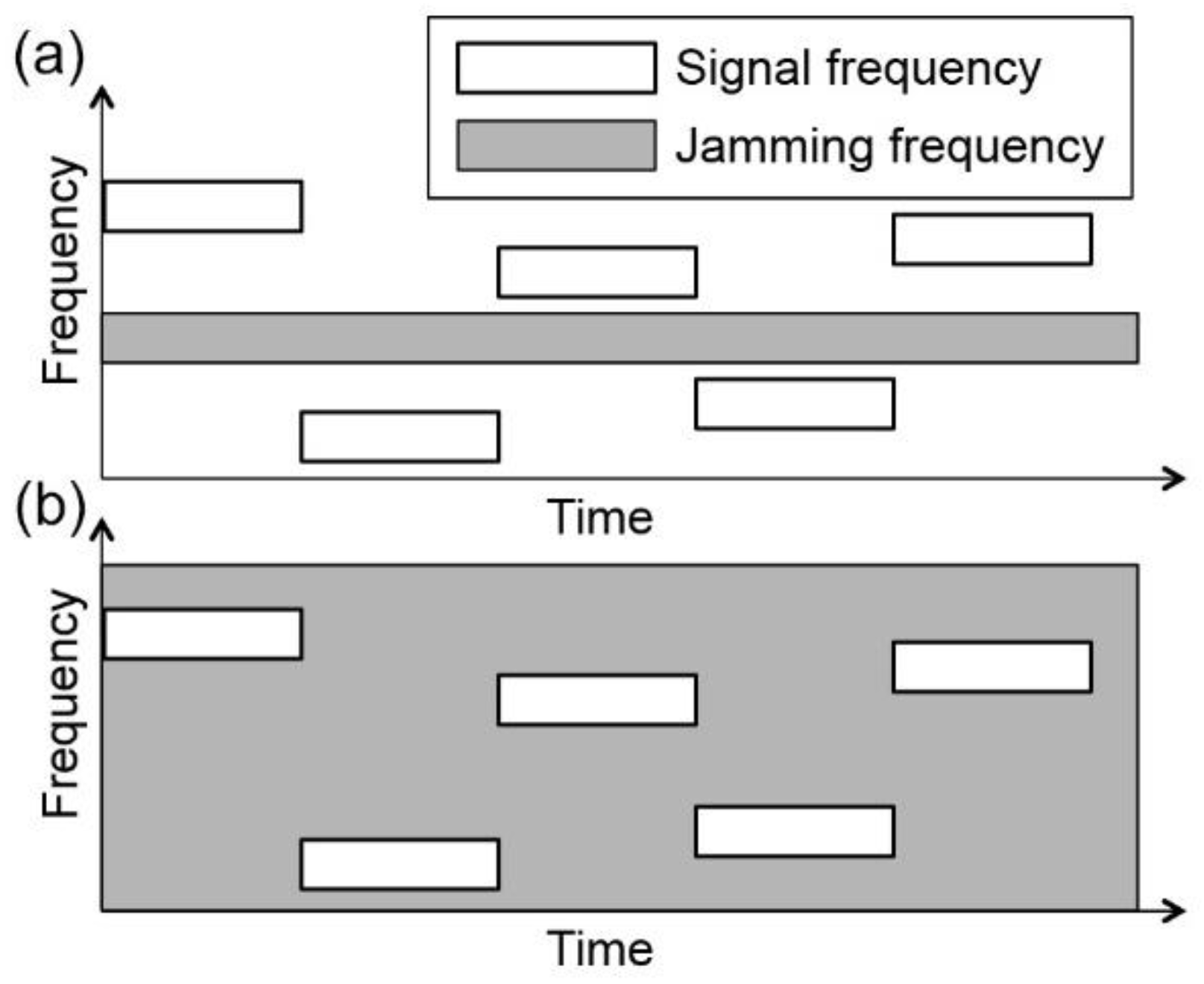
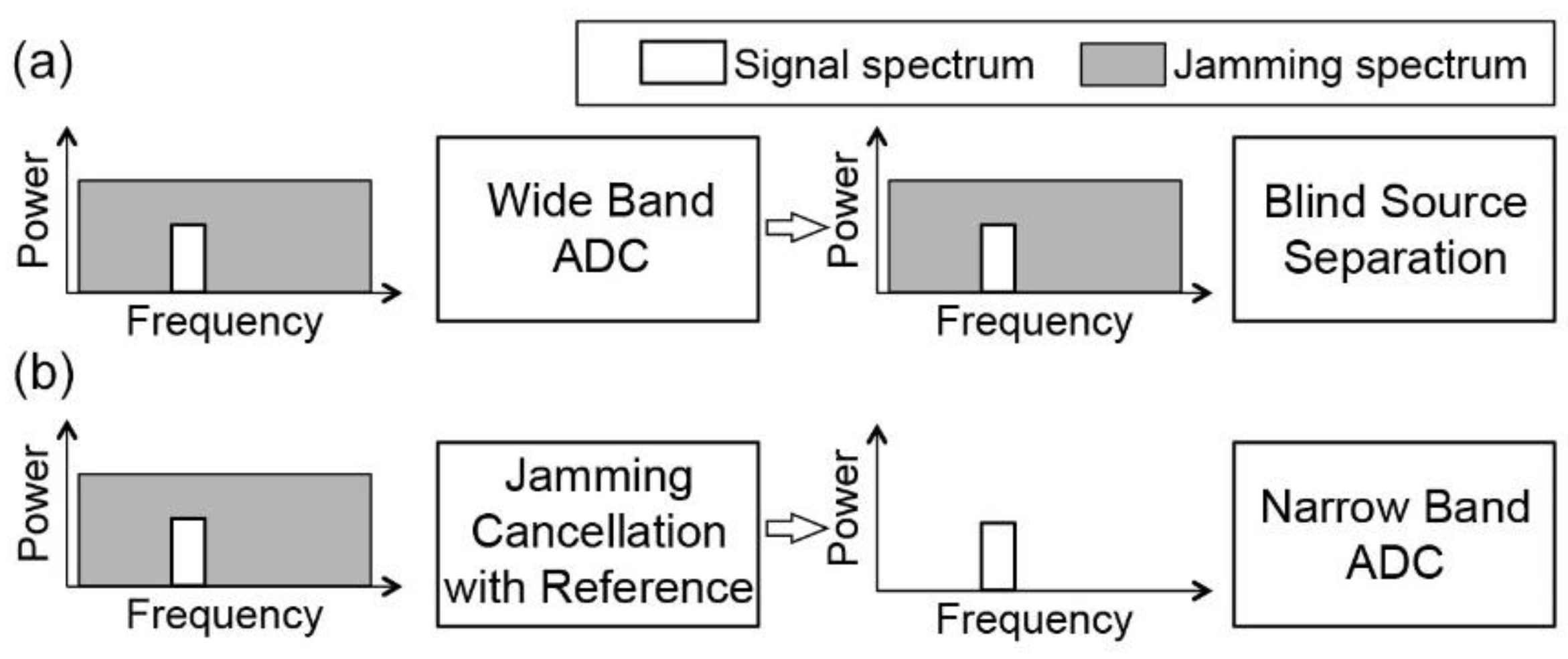
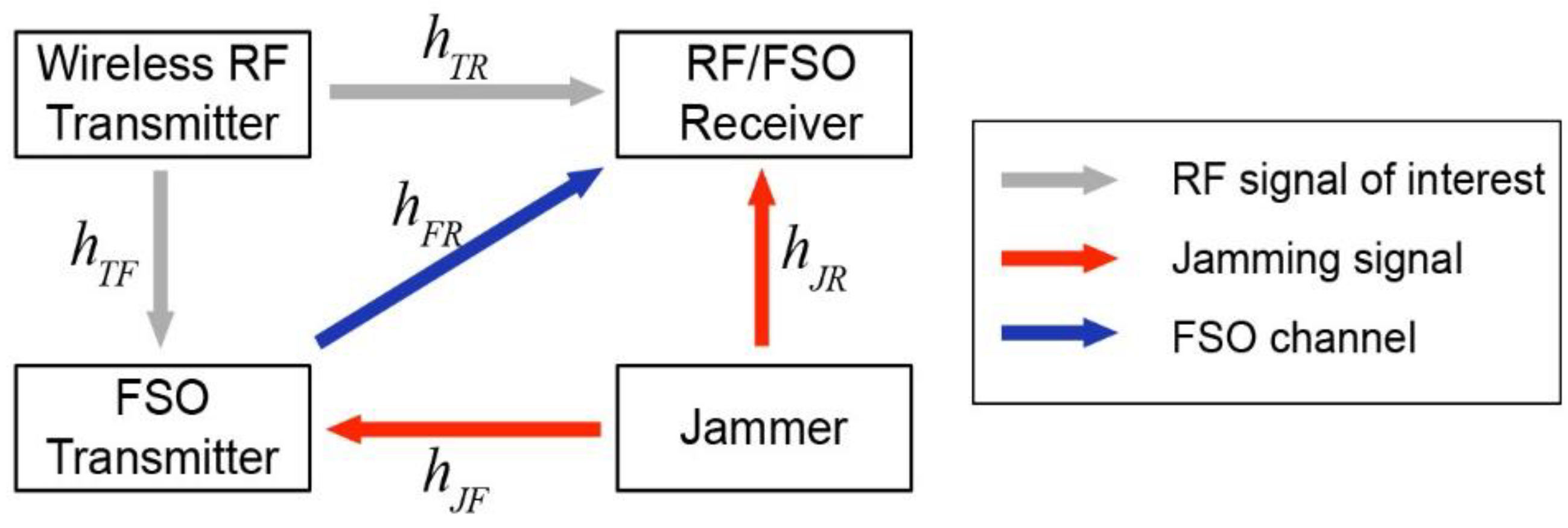


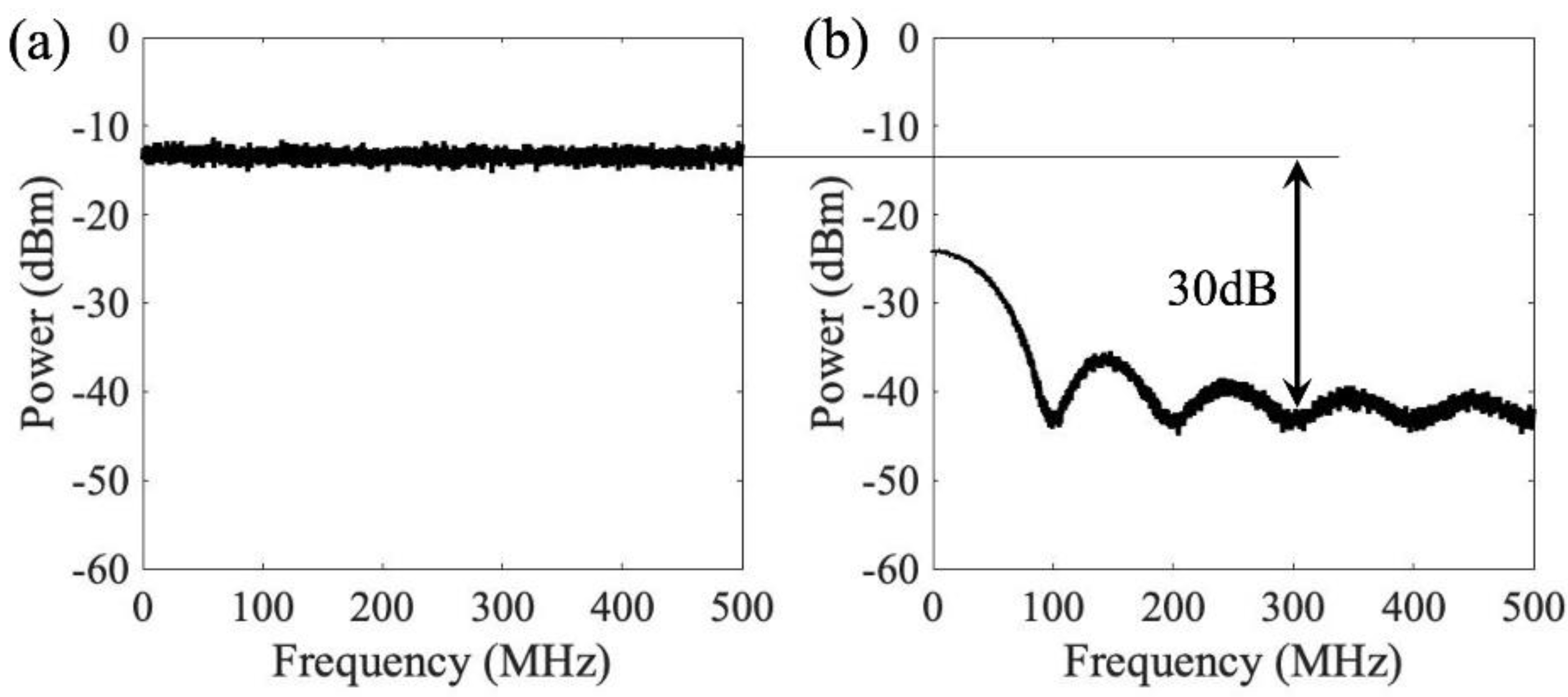
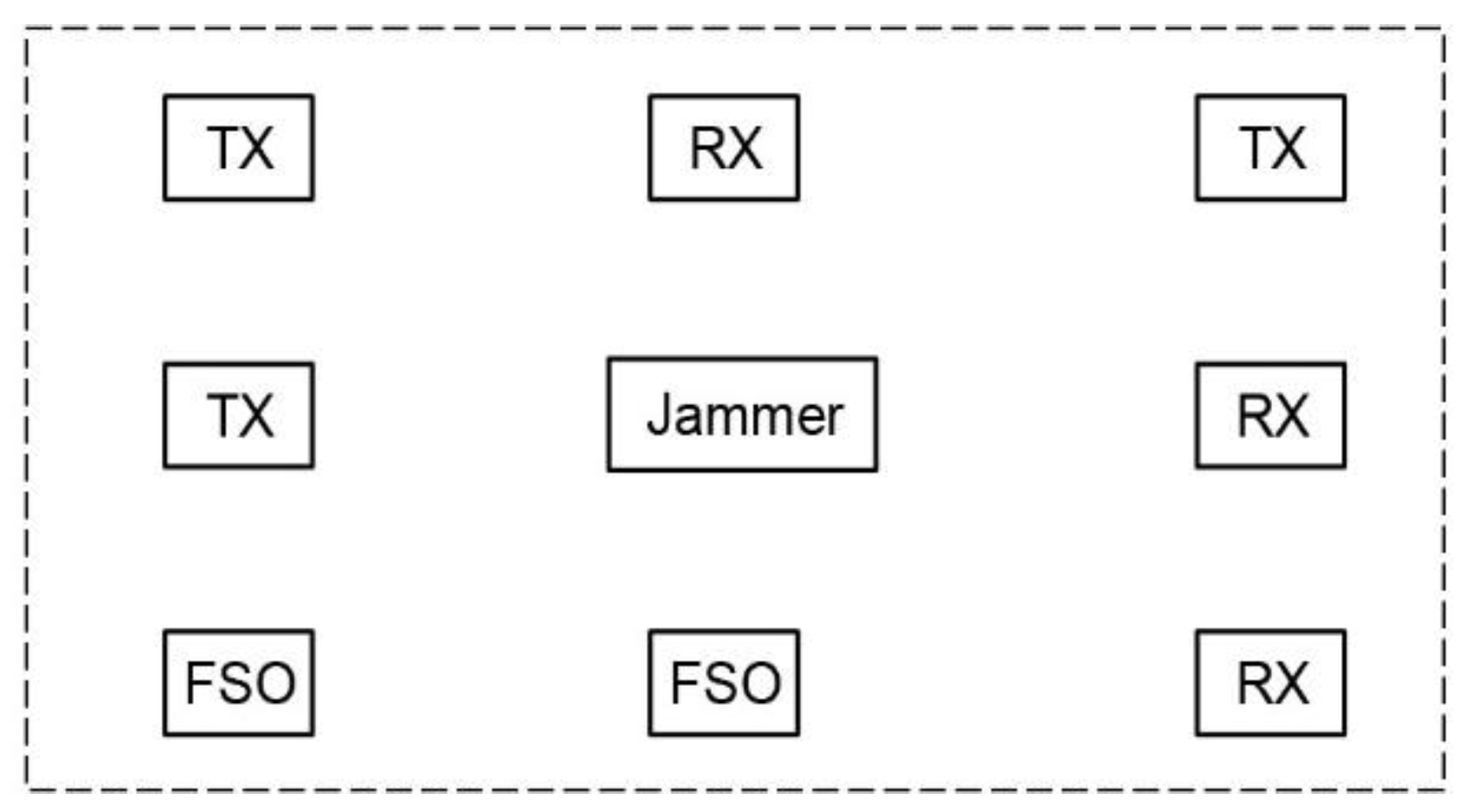

| Description | Spread Spectrum-Based Techniques | Digital Jamming Cancellation | Photonic Jamming Cancellation |
|---|---|---|---|
| Jamming Signal Bandwidth | Narrow | Wide, introduce large latency | Wide, low latency |
| Cancellation ratio | Not applicable | Depend on ADC resolution | Scalable, can be multiplied with multiple stages |
| Latency | Low | High | Low |
| Hardware requirement | Spectrum sensing | MIMO system | FSO system |
Publisher’s Note: MDPI stays neutral with regard to jurisdictional claims in published maps and institutional affiliations. |
© 2021 by the authors. Licensee MDPI, Basel, Switzerland. This article is an open access article distributed under the terms and conditions of the Creative Commons Attribution (CC BY) license (http://creativecommons.org/licenses/by/4.0/).
Share and Cite
Wu, B.; Qi, Y.; Qiu, C.; Tang, Y. Wideband Anti-Jamming Based on Free Space Optical Communication and Photonic Signal Processing. Sensors 2021, 21, 1136. https://doi.org/10.3390/s21041136
Wu B, Qi Y, Qiu C, Tang Y. Wideband Anti-Jamming Based on Free Space Optical Communication and Photonic Signal Processing. Sensors. 2021; 21(4):1136. https://doi.org/10.3390/s21041136
Chicago/Turabian StyleWu, Ben, Yang Qi, Chenxi Qiu, and Ying Tang. 2021. "Wideband Anti-Jamming Based on Free Space Optical Communication and Photonic Signal Processing" Sensors 21, no. 4: 1136. https://doi.org/10.3390/s21041136
APA StyleWu, B., Qi, Y., Qiu, C., & Tang, Y. (2021). Wideband Anti-Jamming Based on Free Space Optical Communication and Photonic Signal Processing. Sensors, 21(4), 1136. https://doi.org/10.3390/s21041136





_Tang.png)

